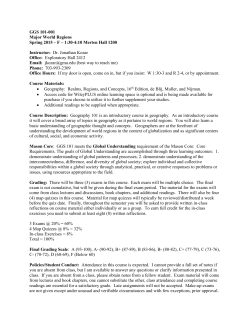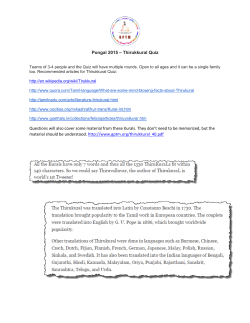
CS&D 210 - University of WisconsinâMadison
CS&D210:TheNeuralBasesofCommunication OnlineCourseSyllabus Specifications:Thisisan8‐weekcoursethatiscompletelyonlinehousedbyD2LonLearn@UWwithanasynchronousformat.Thismeans youcanworkaheadatyourownpace,butwewillbehandlingquestionsanddiscussionspertainingtoactivitiesfortheassignedweek. Therearemodulesthatarethematic,basedonthestructureandfunctionofthenervoussystemastheypertaintocommunicationfunction anddysfunction. Format:Contentdeliveryisanintroductoryaudio+PowerPointrecordingwithmajorthemes,accompaniedbywrittencoursematerialsand assignedreadingsfromthetextbookaswellashyperlinkstovideoexamples.Thereisalsoanonline,interactivebrainatlas. Activities:Thelearnerwilllistentoaudio+PowerPointrecordings,readmaterialsandbookchapters,interactwiththeonlinebrainatlas, takequizzesandexams,andcompleteonewrittenassignmentthatisacriticalappraisalofbookdealingwithacommunicationdisorder. Assessment:10Quizzes(openbook),3exams(closedbook,droplowestexam),writtenassignment,andcomprehensivefinalexam(closed bookbutallowedone8x12paperwithanynotes/figuresonfrontandbackthatwillbesubmittedtotheinstructors). Thiscourseprovidesanoverviewonhowthebraincontrolsfunctionsthatarerelatedtocommunication.Thelearnerwillacquire knowledgeonbasicanatomyandphysiologyofthenervoussystem,withfocusonspeech,language,hearing,andcognition. Further,thelearnerwillunderstandhowdiseases,trauma,andagingmayaffectthesefunctions.Thefollowingarethe overarchingthemesthatguidethestructureandcontentofthecourse. Communicationisvitalforsurvivalandqualityoflife. Communicationismulti‐modalandthusthecontrolofcommunicationbythebrainiscomplex. Despitethecomplexityoftheneuralcontrolofcommunication,therearesomeorganizingprinciplesthathelpuslearnhow todiagnoseandtreatdisordersofcommunicativefunction. Knowinghownormalfunctionbreaksdownwithdiseasesorconditionsthataffectcommunicationhelpstoinformand improvediagnosisandtreatmentofcommunicationdisorders. Instructor GaryWeismer,PhD ProfessorandChair DepartmentofCommunicationSciencesandDisorders UniversityofWisconsin‐Madison gweismer@wisc.edu TeachingAssistant:TBD CourseObjectives‐attheendofthecourse,thelearnerwillbeableto: 1. Useappropriateterminologyrelatedtothestudyofneuroanatomyandneurophysiology. 2. Identifykeystructuresofthecentralandperipheralnervoussystems. 3. Describethebasicdevelopmentofthenervoussystem. 4. Describethemajorcomponentsofthevascularandcerebralspinalfluidsystemstothebrainandspinalcord. 5. Describethepartsofaneuron,aswellasthebasicneurophysiologyofhowneuronsconductelectricaland chemicalsignalingwithinthenervoussystem. 6. Differentiatebetweenthefollowingintermsoffunctionandimpairment:uppermotoneurons,lower motoneurons,corticobulbartract,corticospinaltract. 7. Describethebasiccomponentsofthesensorimotorsystem,includingthebasalganglia,cerebellum,thalamus, primaryandassociationcortices,andascendinganddescendingpathways. 8. Performabasiccranialnerveexam. 9. Identifythebasicneuralcomponentsofthevisualandauditorysystems. 10.Describethemajorneuralcomponentsthatcontributetospeechmotorcontrolandhowdamagetothese contributestomotorspeechdisorders. 11.Identifythemajorlanguageareasofthebrainanddescribehowpatternsofdamagecontributetothevarious manifestationsoflanguagedisorders. 12.Definehigherorderfunctionsofthebrainandexplainhowdeficitsmanifestinpatients. Textbook:Bhatnagar,NeurosciencefortheStudyofCommunicativeDisorders,Lippincot,Williams&WilkinsISBN‐10: 1609138716|ISBN‐13:978‐1609138714|Edition:Fourth Howtocontactus:PostquestiononPiazzaQ&A*‐availablethroughLearn@UW(monitoredweekdaysbyinstructors, makesuretosubscribetoemailupdates).*Thesystemishighlycateredtogettingyouhelpfastandefficientlyfrom classmates,theTA,andtheprofessor.Ratherthanemailingquestionstotheteachingstaff,werequestthatyoutopost yourquestionsonPiazza.Wealsoencouragethestudentstotryandanswerotherstudents’questions,posthelpfullinks andtutorials,andusethisasanonlinecommunity.Ifyouhaveanyproblemsorfeedbackforthedevelopers,email team@piazza.com.Findourclasspageat: piazza.com/wisc/summer2015/csd210_001_su15_dhh CourseRequirements Therewillbe10onlinequizzesduringthesemester,onecourseproject(assignmentonLearn@UWfordetails),3 examinationsandacomprehensivefinalexamination.Thequizzesareonlineandopennote.Youwillhave2 opportunitiestotakethesequizzeswithina48‐72hourperiod(seeschedulebelow).Theyaredesignedtotestyour understandingofthematerialandprepareyoufortheexams.Thereare3examinations,however,onlyyourtwo highestscoreswillcounttowardyoufinalgrade.Inotherwords,yourlowesttestscorewillbedropped.Assuch,there arenoexcusedabsencesforquizzesortests. OnlineQuizzes10at10points 100 CourseProject50points 50 Exams3at100points(droplowestscore) 200 ComprehensiveFinalExam 100 Total 450 Scale:94‐100%=A88‐93%=AB82‐87%=B76‐81%=BC70‐75%=C60‐69%=D>60%=F CourseSchedule Date Module Opens 06/15/2015 06/17/2015 06/19/2015 06/22/2015 06/24/2015 Module Topics Introduction to course, syllabus, review basic terms Parts of the nervous system, gross anatomy of NS Development of the Nervous System Ventricles, meninges, blood supply Readings (from Bhatnagar) Chapter 1 Date of quizzes and exams (close at 11:59pm) Chapters 2 (pp. 35‐76), 3 (95‐100) Chapter 4 Chapters 2 (pp. 76‐84), 7,8 Chapter 5 Quiz 1 Intro, gross anatomy: 06/19/2015 07/01/2015 07/06/2015 07/08/2015 07/10/2015 parts of a neuron, action potential, action potential propagation neurophysiology, neurotransmitters, chemical signaling Catch‐up, Exam Review Visual System, Auditory System Limbic System 07/13/2015 07/15/2015 Sensorimotor system 1 Sensorimotor system 2 07/17/2015 Gross Anatomy of the Brainstem, Cranial Nerves Chapters 13, 14, 15, 16 Chapters 11, 13, 14, 15, 16 Chapter 3 (100‐110), Chapter 17 07/20/2015 07/24/2015 07/27/2015 07/29/2015 07/31/2015 08/03/2015 Review for exam 2 Speech motor control, motor speech disorders Language Part 1 Language Part 2 Disorders Higher Order Function Part 1, Higher Order function Disorders Chapter 19 Chapter 19 Chapter 19 08/04/2015 08/08/2014 Review Exam 3 Review for Cumulative Final 06/29/2015 Chapter 5 Chapter 12 Chapter 9 Chapter 18 Quiz 2 development, ventricles, etc.: 06/25/2015 Quiz 3 Action potential: 06/29/2015 Quiz 4 Neurotransmitters, etc.: 07/01/2015 Exam 1: 07/03/2015 Quiz 5 Auditory and visual systems: 07/10/2015 Quiz 6 Motor System: 07/17/2015 Quiz 7 Brainstem, cranial nerves: 07/20/2015 Exam 2: 07/23/2015 Quiz 8 Motor speech disorders: 07/27/2015 Quiz 9 language disorders: 07/31/2015 Quiz 10 Higher order : 08/04/2015 Exam 3: 08/05/2105 Cumulative Final Exam 08/07/2015 Book assignment due 08/07/2015
© Copyright 2025









